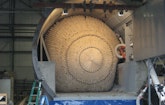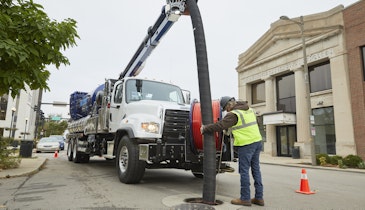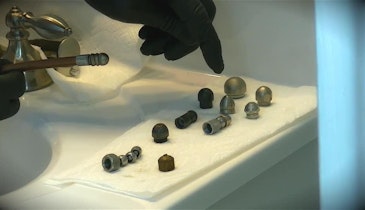
Interested in Municipal/Industrial?
Get Municipal/Industrial articles, news and videos right in your inbox! Sign up now.
Municipal/Industrial + Get AlertsHurricane Sandy devastated the northeast coast in October 2012. Recovery efforts are still underway. Significant damage was caused by the flooding of subway and transit tunnels in New York, many of which will remain closed for months. The storm surge from the hurricane, combined with a high tide and heavy rains, saw seawater levels 10 to 14 feet above normal. Some tunnels were flooded to the ceiling.
Mechanical storm gates are in place at some sites around the country, but they’re slow to operate, expensive to maintain, and not compatible with all infrastructure. There might be an alternative on the horizon: massive inflatable plugs designed to halt intruding flood waters. In addition, they could stop smoke from fires, and airborne hazards such as biological or chemical agents deployed by terrorists.
In 2007, the Department of Homeland Security initiated a program called the Resilient Tunnel Project. They provided funding for R&D to look at solutions that could protect this vital infrastructure. The DHS Science and Technology Directorate teamed with Pacific Northwest National Laboratory, West Virginia University, and ILC Dover to find the solution.
The work is on
“This is just one of many projects,” says John Fortune, Ph.D., DHS Science and Technology Directorate program manager. “We’re charged with protecting all aspects of this country’s infrastructure. That includes rail lines, bridges, airports, the power grid … pretty much anything critical to the operation of the United States.”
Jon Hinkle, ILC lead design engineer, says, “Early on in the project, WVU and DHS suggested the feasibility of using an inflatable plug instead of conventional storm gates. They knew ILC had experience and expertise in this area, with inflatable products known in the business as ‘soft goods structures.’ So that’s how we got on board.” ILC’s experience included NASA space suits, and the “airbags” that bounced the Mars Exploration and Mars Pathfinder Rovers gently to rest on the martian surface.
ILC’s inflatable plugs, called Resilient Tunnel Plugs (RTP), are similar in concept to those used in water and sewer applications for sealing mains and laterals for smoke testing or flow diversion. But RTPs are huge, measuring some 16 feet in diameter and 32 feet long. And unlike conventional plugs composed of reinforced rubber, RTPs employ three layers of high-tech materials.
Test run
In January 2012, DHS tested a prototype RTP created by ILC. It successfully held back water in a test tunnel, withstanding pressures of 10 to 20 psi. That equates to a water head of about 46 feet — far in excess of most storm surges, and even some tidal waves. Nominal operating pressures are lower, but ILC engineered a factor-of-four safety margin for this critical application.
“Even with an RTP designed and built for specific tunnel sizes and shapes, a 100 percent seal is impossible,” says Hinkle. “Existing infrastructure such as conduit and plumbing will create some gaps.” Further, all tunnels have built-in venting and drainage systems, and they can add to water infiltration.
“Fortunately, all tunnels have existing pumping capacity to eliminate water from whatever source. That existing capacity would suffice, if the tunnel has an RTP, even in a storm like Hurricane Sandy,” says Hinkle.
The same reasoning applies to tunnel infiltration by smoke from fires, or airborne hazards from chemical or biological weapons. All tunnels also have ventilation systems that could handle any infiltration past the RTPs. In fact, the first prototype tested was used to seal a tunnel against smoke from a smoke generator. It passed that test.
“You can’t just put an RTP anywhere and expect it to do its job,” says Fortune. “Some modification to the tunnel will be necessary. Sharp corners would be rounded off, conduit and plumbing recessed, and the third rail removed from that section of track. We’re talking maybe 50 feet of tunnel here, since the plugs are 32 feet long.
“At present, we’re really focused on preventing flooding, but we did consider the potential for blocking airborne hazards. DHS Science and Technology is doing some studies now with Boston Metro on how air flows through a tunnel system, and it’s a lot different from how water flows. But the concept is reasonable.”
Composition and inflation
When an RTP is deployed against flooding, there will be a lot of tunnel debris hitting it. “We anticipated that,” says Hinkle, “but the material we chose is pretty tough to puncture. That’s what the ‘R’ in RTP is all about.”
Three carefully selected layers compose the shell of an RTP, which needs to be strong, flexible, impermeable, and collapsed into a storage container (usually mounted on a wall of the tunnel) from which it could be remotely deployed. The RTP is held into the container by a fabric cover which is “unzipped” by an initiator. Once free of its container, the RTP would be in the correct position to continue inflation to full design pressure.
The outermost layer is a fabric webbing of Vectran, a liquid-crystal polymer similar to DuPont’s Kevlar, but with more flexibility. Its cross-hatched weave provides the strength necessary for high-pressure inflation, and increases friction between the RTP and tunnel walls. The middle layer is a different weave of the same material, but designed to resist punctures, not unlike a bullet-proof vest. The innermost layer is a urethane-based bladder, similar to that used in blimps, and contains the inflatant.
An RTP can be inflated with either air or water. “Although inflation with air is faster, it requires the installation of compressors, tanks of compressed air, or gas generating chemicals,” says Hinkle. “But water is already on tap in most tunnels, available from existing plumbing.” Filling an RTP with water adds to its weight making it harder to dislodge. An empty RTP weighs 2.4 tons. Fill it to capacity with 35,000 gallons of water, and you’ve got another 146 tons.
“Initial inflation would be with air in all cases, since the weight of water would impede proper deployment and positioning,” says Fortune. “Only after it’s in place would it be filled with water or air and fully pressurized. That’s one of the things we’re studying now — the effectiveness of water versus air inflation, and which inflation system works best for a particular tunnel.”
RTPs can be used more than once, but need to be returned to ILC for pressure testing and inspection before redeployment. Getting the RTP back into its container is a process similar to packing a parachute, with folds being made at the correct locations and proper orientation within the container. The fabric cover is then re-zipped, and a cinching lace used to tighten the cover for compact storage.
Fortune draws an analogy to a familiar technology: “It’s not unlike automobile airbags. They have to stay tucked up in a small space, and sit there for years exposed to vibration and temperature and humidity variations. But when you need it, it absolutely has to deploy properly.”
Production makes perfect
“ILC is still about two years from fully tooling up to the production stage,” says Hinkle. “Additional work on the fill mechanism, subsystem integration, and overall system reliability is ongoing.” When completed, he estimates the turnaround between orders and installation will be a few months. Each RTP must be designed and built for specific tunnel applications.
The prototype RTP built by ILC, and successfully tested by WVU, cost $400,000. Commercially available units may come in at a lower price with improvements in the manufacturing process. ILC has no estimates yet of what that cost might be, but as with any “insurance,” the damages prevented would far outweigh the cost.
The choice of whether or not to use RTPs would be up to individual jurisdictions and transit authorities. “What we do is provide a toolbox of solutions,” says Fortune. “For the RTPs, we’ve been coordinating with TSA and other government agencies, talking to various municipalities, and looking at where this solution might work best.”
How many RTPs would be needed to secure all essential tunnels in the country? Obviously, major coastal cities would be the first customers. Hinkle notes that even cities on the Great Lakes might be interested. When the tail end of Hurricane Sandy reached the Midwest, Lake Michigan saw 17-foot waves. And transit or subway tunnels are not the only points of application. Many stormwater tunnels discharge at locations where a storm surge could create devastating backflows.
As with so many other innovations, necessity is the mother of invention. Efforts to prevent damage from natural disasters are too often reactive instead of proactive. With climatologists predicting an increase in violent weather events, RTPs just might become as commonplace as levies and breakwaters.







